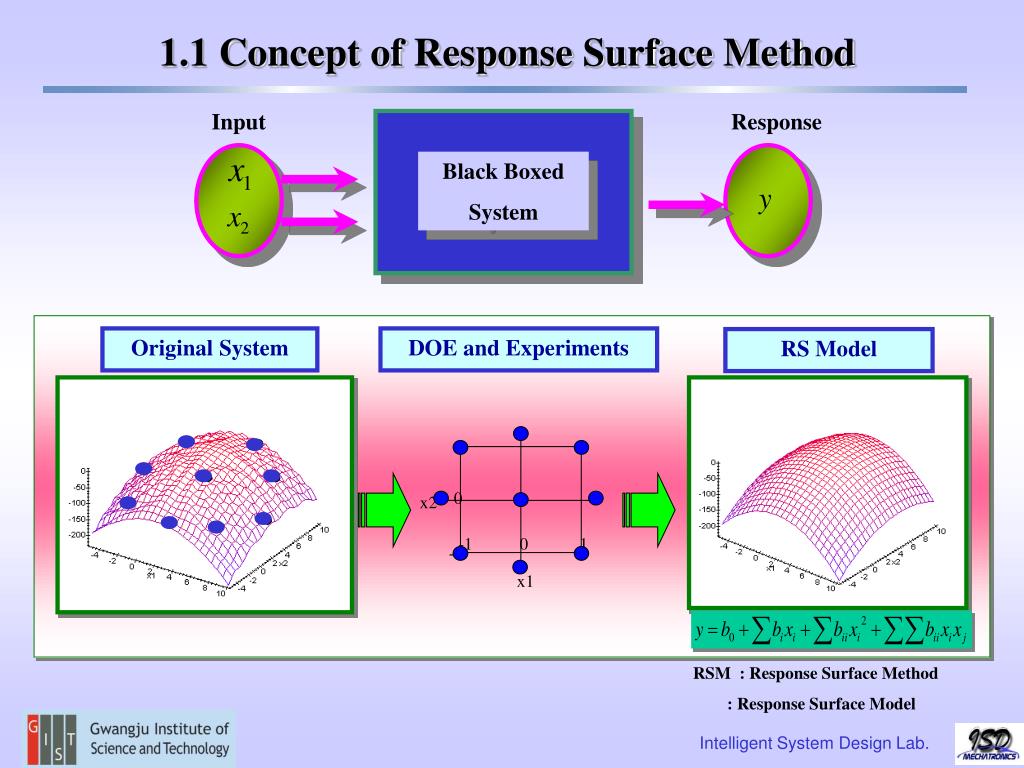
Design of Experiment II Response Surface Methodology (RSM) (DOE102
Response Surface Design and Analysis¶ This tutorial, the first of three in this series, shows how to use Design-Expert® software for response surface methodology (RSM). This class of designs is aimed at process optimization. A case study provides a real-life feel to the exercise.

Steps for response surface methodology (RSM) application. Download
Response surface methodology (RSM), introduced by Box and Wilson,1 is a collection of mathematical and statistical techniques whose purpose is to analyze, by an empirical model, problems as the one posed. More concretely, its objectives are the following: • To generate knowledge in the experimental domain of interest. •

Response Surface Models (RSM)
Response-surface methodology comprises a body of methods for exploring for optimum op- erating conditions through experimental methods. Typically, this involves doing several ex- periments, using the results of one experiment to provide direction for what to do next.

Response surface methodology plot of interactions between the
Response surface methodology (RSM) and artificial neural networks (ANN) are considered the most efficient way for optimization and modeling studies to design and develop various biosimilars.

Introduction to Response Surface Methodology RSM Design and Analysis
Response surface methodology (RSM) as a tool for optimization in analytical chemistry - ScienceDirect Talanta Volume 76, Issue 5, 15 September 2008, Pages 965-977 Review Response surface methodology (RSM) as a tool for optimization in analytical chemistry Marcos Almeida Bezerra a b , Ricardo Erthal Santelli a , Eliane Padua Oliveira a ,

Response Surface MethodologyResponse surface plot (RSM) YouTube
Response surface designs. Response surface models may involve just main effects and interactions or they may also have quadratic and possibly cubic terms to account for curvature. Earlier, we described the response surface method (RSM) objective. Under some circumstances, a model involving only main effects and interactions may be appropriate.

Graphical representation of response surface methodology (RSM) for (A
Response Surface Methodology and its sequential nature for optimizing a process First order and second order response surface models and how to find the direction of steepest ascent (or descent) to maximize (or minimize) the response How to deal with several responses simultaneously (Multiple Response Optimization)

Response Surface Methodology RSM tutorial YouTube
A statistical technique for enhancing the process parameters of chemical reactions is called Response Surface Methodology (RSM) [15]. To create the best possible operating circumstances, RSM.

What is Response Surface Methodology RSM Design of Experiments DOE and
In statistics, response surface methodology ( RSM) explores the relationships between several explanatory variables and one or more response variables. RSM is an empirical model which employs the use of mathematical and statistical techniques to relate input variables, otherwise known as factors, to the response.

Flow chart of the response surface methodology (RSM) technique
Response surface methodology (RSM) is an area of statistics that incorporates the use of design and analysis of experiments along with model fitting of a response of interest denoted by y.

Flow chart of the response surface methodology (RSM) technique
The techniques are called response-surface methods or response-surface methodology ( RSM ). Download chapter PDF Until now, we have considered how a dependent variable , yield, or response depends on specific levels of independent variables or factors .

Graphical demonstration of Surface Response Methodology (SRM), modeling
DOE is a statistical tool that examines factors and their different levels simultaneously by a reduced number of experiments via fractional factorial models such as response surface methodology (RSM) to evaluate more relevant interactions among variables . RSM has been used in various studies to optimize the formulation and expression of.

Response surface methodology (RSM) plots of formulation optimization
Response surface methodology (RSM) was effectively used for the optimization and modelling of a wide variety of microbial products. This method is a combination of statistical and mathematical technique for model construction, assessing the effect of several independent variables and getting optimum values of variables.

ac Response surface methodology diagrams for juice yield () as a
Response Surface Methodology (RSM) is an optimization tool that can identify interrelationship between variables as being adopted by experiment/ research studies in food and herbal plants.

What Is Response Surface Methodology Rsm Design Of Experiments Doe And
This chapter first summarizes Response Surface Methodology (RSM), which started with Box and Wilson's 1951 article on RSM for real, non-simulated systems. RSM is a stepwise heuristic that uses first-order polynomials to approximate the response surface locally. An estimated polynomial metamodel gives an estimated local gradient, which RSM.

RSM Introduction to Response Surface Methodology YouTube
12.1 Introduction. Response Surface Methodology refers to statistical and numerical techniques to model the relationship between multiple input variables and an output variable. A Response Surface Method (RSM) can be considered as a multidimensional surface fitting of the output variable based on the observed data in multidimensional input space.